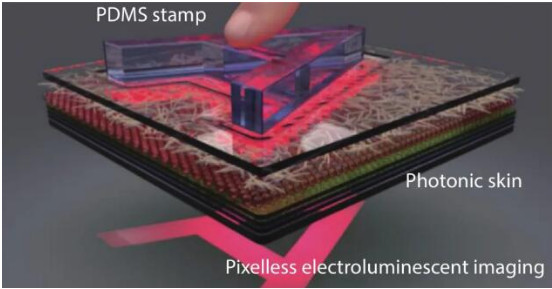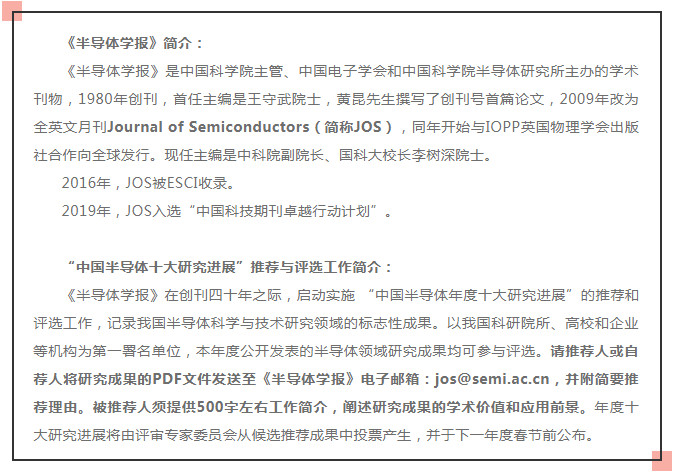近年来,柔性传感器的发展受到了科研人员和工业界的广泛关注。因为采用的传感器相比,柔性传感器不需要使用硬质的塑料和金属部件,可以和非平面表面(复杂形状的物体或生物表面)交互,极大地拓宽了传感器的性能和应用范围。但是,单一材料的固有特性有时候会限制柔性传感器的进一步发展。为了能够更好地展示柔性传感器的应用优势,越来越多的研究人员将他们的注意力转移到复合杂化材料上。
在最新出版的《半导体学报》第4期News and Views栏目中,中国科学院半导体研究所魏钟鸣研究员和昆士兰科技大学的Prashant Sonar教授、Dongchen Qi博士等发表题为“Flexible sensors based on hybrid materials”的评论文章,简述了基于杂化材料的不同功能传感器最近发展情况。评述还分析了当前研究面临的挑战和不足,也对杂化材料在柔性传感器应用方面的发展前景进行了展望。
Abstract
With the rapid development of mobile Internet and intelligent devices, flexible electronic technology has attracted wide attention driven by the huge demand of the market. As one type of flexible electronic devices, flexible sensors have attracted great interest because of their promising prospects in artificial intelligence, medical health, and environmental protection. In recent years, flexible sensors with high sensitivity, selectivity, good deformability, reliable stability, and portability are urgently needed to meet the developments of artificial skin, human-computer interaction, point of care diagnostics and wearable electronic devices.
The selection of materials is critical for the fabrication of sensors. Excellent material properties contribute to flexible sensors with high sensitivity, wide detection, or superior durability. In fact, various high-quality materials, including metals, inorganic semiconductors and conjugated organic semiconductors, are some the most widely used and important ones. Compared with single-component materials limited by their inherent properties, researchers find that the hybrid composite of organic and inorganic materials combination can enhance the final performance of sensors, which brings synergetic advantages from the set of individual physicochemical properties combining the excellent flexibility of organic polymers with the structural support and good conductivity of inorganic semiconductors. What’s more, the function of the materials can be “cut” and “assembled” to meet the demands of people by adjusting the proportion of the organic phase and the inorganic phase components in hybrid materials.
In recent years, various flexible sensors based on hybrid materials have been fabricated to detect different signal stimuli such as pressure, deformation, humidity, light, heat, gas, current. For example, Shen’s research group reported a strain sensor based on the nanostructures of poly (vinylidene fluoride–trifluoroethylene) (PVDF-TrFE) fibers/ZnO nanowires composites[1]. The as-fabricated device can also function properly when transferred to the fingers to detect muscle movements such as finger bending or straightening. Polydimethylsiloxane/Ag-nanowires composite dielectrics can be used to fabricate a flexible, transparent and ultra-sensitive capacitive pressure sensor[2]. Capacitive sensors generally exhibit better linearity, less hysteresis and better repeatability than resistive sensors, but resistive sensors are generally more sensitive[3]. Temperature sensors obtained via combining the pyroelectric polymer and BrTiO3 nanomaterial have been demonstrated as an accurate device with standard deviation of 0.006–0.012 Kelvin[4]. TiO2-nanoparticles/polypyrrole and TiO2-nanoparticles/polypyrrole/poly-[3-(methacrylamino) propy] trimethyl ammonium chloride composite thin films formed by the in-situ photopolymerization can be utilized to fabricate flexible resistive-type humidity sensors, where different centration of water vapor in air leads to a change of the material conductance[5]. For optical sensing, organic–inorganic poly(3-hexylthiophene)/CdSe-nanowire heterojunction photodetectors have exhibited good photoelectric performance and potential application prospect as image sensors[6]. In addition, the performance of sensing elements is largely determined by the structural design of a sensor. For example, flexible pressure sensors based on a Ti3C2/natural-microcapsule-biocomposite film mimicking the skin structure have excellent flexibility, mechanical deformability, and the ability to detect weak physiological signals[7]. Recently, gas sensors composed of ultrathin single-walled carbon nanotubes and chitosan with reference to the three-dimensional biomimetic templating of a structurally hierarchical butterfly wing enable the highly selective detection of diabetes-related volatile organic compounds[8]. With the further development of interdisciplinary research, more flexible hybrid materials with good electrical properties will be developed. Emerging organic-inorganic hybrid perovskite materials, such as CH3NH3PbI3 (MAPbI3) and MAPbBr3, have exhibited highly attractive photoelectric characteristics. These materials are promising candidates for high-performance flexible image detectors[9]. Electroluminescent sensors composed of hybrid materials also have greatly competitive advantages in electronic skin applications through visualizing accurate stimulus distribution[10], the reliability of the pressure map by sensors can be proved (Fig. 1).

Figure 1. (Color online) Schematic illustration of the photonic skin. Reproduced with permission[10] . Copyright 2020, Nature Publishing Group.
At present, organic/inorganic hybrid sensors remain in the research & development stage. The physicochemical mechanism of hybrid materials needs to be further studied through optimizing hybrid materials or designing hybrid structures. Moreover, most sensor systems still require external power sources, which limits the use of sensors in fields such as flexible wearable electronics and medical health. Self-powered materials based on piezoelectric, frictional or thermoelectric effects can be envisioned. We believe that the unique advantages provided by hybrid materials, coupled with innovations in sensor device architectures, can greatly accelerate the development of flexible sensors in the next few years.
References
[1]Shuai C, Zheng L, Di C, et al. Highly flexible strain sensor based on ZnO nanowires and P(VDF-TrFE) fibers for wearable electronic device. Sci China Mater, 2016, 59(3), 173
[2]Shi R, Lou Z, Chen S, et al. Flexible and transparent capacitive pressure sensor with patterned microstructured composite rubber dielectric for wearable touch keyboard application. Sci China Mater, 2018, 61(12), 1587
[3]Shintake J, Piskarev E, Jeong S H, et al. Ultrastretchable strain sensors using carbon black-filled elastomer composites and comparison of capacitive versus resistive sensors. Adv Mater Technol, 2017, 1700284
[4]Tien N T, Jeon S, Kim D I, et al. A flexible bimodal sensor array for simultaneous sensing of pressure and temperature. Adv Mater, 2014, 26(5), 796
[5]Su P G, Wang C P. Flexible humidity sensor based on TiO2 nanoparticles-polypyrrole-poly-[3-(methacrylamino)propyl] trimethyl ammonium chloride composite materials. Sens Actuators B, 2008, 129(2), 538
[6]Wang X, Song W, Liu B, et al. High-performance organic–inorganic hybrid photodetectors based on P3HT:CdSe nanowire heterojunctions on rigid and flexible substrates. Adv Funct Mater, 2013, 23(9), 1202
[7]Wang K, Lou Z, Wang L, et al. Bioinspired interlocked structure-induced high deformability for two-dimensional titanium carbide (MXene)/natural microcapsule-based flexible pressure sensors. ACS Nano, 2019, 13(8), 9139
[8]Wang L, Jackman J A, Park J H, et al. A flexible, ultra-sensitive chemical sensor with 3D biomimetic templating for diabetes-related acetone detection. J Mater Chem B, 2017, 5(22), 4019
[9]Gu L, Tavakoli M M, Zhang D, et al. 3D arrays of 1024-pixel image sensors based on lead halide perovskite nanowires. Adv Mater, 2016, 28(44), 9713
[10]Lee B, Oh J Y, Cho H, et al. Ultraflexible and transparent electroluminescent skin for real-time and super-resolution imaging of pressure distribution. Nat Commun, 2020, 11(1), 663
作者简介
魏钟鸣,中国科学院半导体研究所半导体超晶格国家重点实验室研究员,中国科学院大学岗位教授。
曾任丹麦哥本哈根大学助理教授,2015年入职中国科学院半导体研究所,主要研究方向是低维半导体材料与器件。
点击阅读魏钟鸣研究员文章:
Flexible sensors based on hybrid materials
Zhihui Ren, Dongchen Qi, Prashant Sonar, Zhongming Wei
J. Semicond. 2020, 41(4): 040402
doi: 10.1088/1674-4926/41/4/040402
Full text
“柔性材料与结构”专刊
《半导体学报》组织了一期“柔性材料与结构”专刊,并邀请复旦大学梅永丰教授、美国加州理工学院高伟助理教授、美国东北大学方辉助理教授、电子科技大学林媛教授和中科院半导体研究所沈国震研究员共同担任特约编辑。该专刊已于2020年第4期正式出版并可在线阅读,欢迎关注。
专刊详情请见:半导体学报2020年第4期——柔性材料与结构专刊


